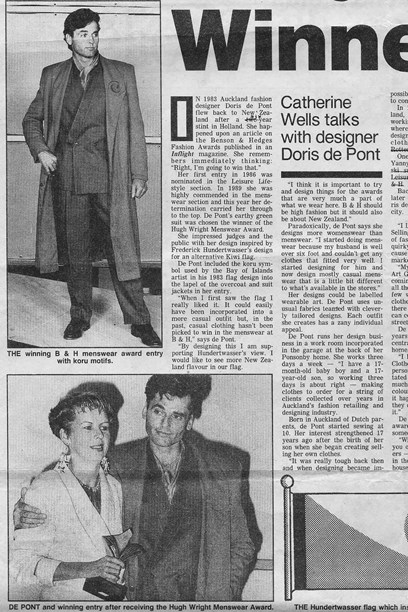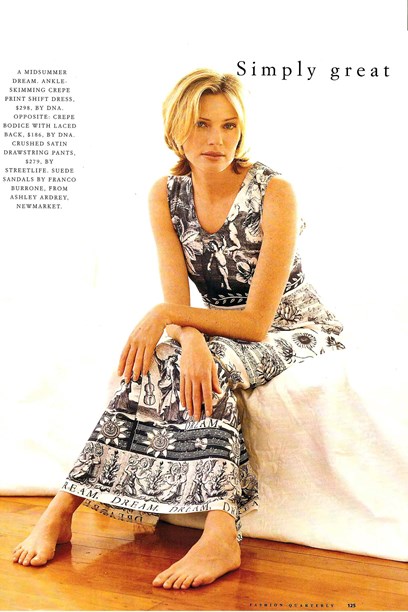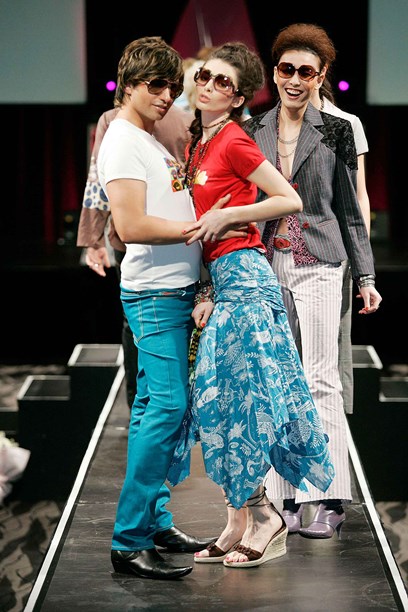Stories
Doris de Pont
1954-

Doris de Pont designed many garments over her four decades of professional fashion-making, and all reflect a distinctive, individual aesthetic. Yet alongside that individualism, her experiences in fashion were often intensely collaborative. Her interest in the creativity of others, and her ability to work collectively, underpins her founding of the New Zealand Fashion Museum and her continued championing of New Zealand fashion. Both of her fashion careers are connected through her ongoing exploration of the ways clothing can signify or express identity and belonging.
Doris was born in Auckland in 1954, only a couple of years after her parents emigrated from the Netherlands. Both of her grandfathers contributed to the garment industry in Tilburg, a famous centre of woollen fabric manufacture. Her father’s family had made shoes and football boots; her maternal grandfather was trained as a tailor and owned a family clothing business dating from 1840. They sent annual clothes parcels to their six grandchildren in New Zealand, and Doris recalls their contents as quite different from the attire available in New Zealand at the time. Some children might have found this embarrassing, but Doris found it inspirational. She learned to sew at a young age, and did her own fabric shopping: "We didn’t have a lot of money so the only way I could have something I wanted was to make it myself. That’s really where it started."
Doris continued to sew while studying her Bachelor of Arts in anthropology and political studies at the University of Auckland in the early 1970s, selling garments at a ‘hippy shop’ owned by friends in 1973, the year her eldest son was born. She made scarf skirts, jackets and tops for the young people who also shopped at venues like the Cook St Market. But at this point, it was far from clear that she would continue to make clothes professionally. She went on to study teaching alongside her BA, and worked as a teacher for several years before heading to the Netherlands on her OE and in search of her identity.
She worked for several years at the Steiner School in The Hague, but a period of volunteering and temping after this allowed her the spare time to develop her fashion experience, and the opportunity to begin selling her garments again. While temping, she noticed a new shop had opened: Studio Split was a collective of six women studying fashion at the Rotterdam Academy. They agreed to sell Doris’ garments on her behalf, and she took advantage of this, developing signature pieces, including a unisex reversible raincoat. "It had big fat shoulder pads and was made out of bold printed fabric on one side and plain on the other."
Moving back to New Zealand in the mid-1980s, Doris was now confident that she could make a go of fashion, and began supplying Ponsonby boutique Harijuku with garments. She also decided to upskill, and enrolled in evening pattern-making classes at Auckland Institute of Technology, where she met Trelise and Jack Cooper, both taking the classes to prepare for the launch of Trelise’s own clothing range. It was through the Coopers that Doris acquired the lease on her first shop, in O’Connell St, around the corner from Vulcan Lane. Design: Doris de Pont was opened in June 1985. By the end of that year, her garments were being featured in ChaCha magazine, and Doris was being hailed as a ‘local fashion luminary’. From 1986, Doris began entering the Benson & Hedges Fashion Design Awards, and was particularly successful in the menswear category, awarded runner-up in 1988, and winning in 1990 with a suit inspired by Hunderwasser’s koru-based New Zealand flag design.

Doris de Pont pictured in the Auckland Star after winning the Menswear award at the Benson & Hedges Fashion Design Awards, 24 April 1990.
One of her points of difference, at a time when New Zealand import restrictions limited the availability of fabrics, was that she designed her own. This was what first brought her into collaboration with Adrienne Foote, known for her textile design and screenprinted fabrics and garments. Doris had two more children, and took a break from fashion retailing in the early 1990s, during which time she produced made-to-measure garments for men and women and worked on commissions. Though only some of these really stretched her design sensibilities, she had creative freedom in others. For one of these, the uniforms for the New Zealand team at the Gay Games in New York in 1994, she used a commissioned variation on an Adrienne Foote fabric which declared a Nuclear-Free Pacific. Like the Hunderwasser suit, these uniforms reflected Doris’ explicit engagement with the iconography of 'New Zealandness.
Doris and Adrienne went into business together in 1994, opening DNA in Adrienne’s workroom space next to St Kevin’s Arcade. Their first collection, Summer 1994/1995, was put together in about six weeks, and established the basic motifs of their collaboration: fashion-forward garment shapes, unique collaged screenprinted fabrics, often combining classical statuary and botanical or other scientific engravings, and a limited but flexible colour palette. It took off straight away, being picked up by local and Australian retailers and featured in Fashion Quarterly and More magazine. Collections gradually increased in scale, and in 2001 a diffusion label, dna, was added to the stable. DNA and dna also found markets in the Northern hemisphere – they retailed in London and Denmark.

DNA's first collection pictured in Fashion Quarterly, Summer 1994. Image © Fashion Quarterly.
Doris and Adrienne decided to go their separate ways in 2002, and Doris purchased the company. Her husband, Tejo van Schie, became her business partner and his unwavering support remains highly visible at Fashion Museum exhibitions to this day. Together they consolidated and expanded the company, securing international agents in New York and the Netherlands, and retailers in Japan. The 'DNA' label changed to 'Doris de Pont' from 2003 onwards, on the advice of her New York fashion agent. Though her designs sold globally, the locality and particularity of her vision was always important to buyers, and by giving her clothing her own name she cemented 'identity' at the core of her practice.
With her renamed label, Doris transposed her collaborative practice from one fabric designer to many: each collection she began a new collaboration with an artist to create signature fabrics. The first collection under this model, Let’s Gather Here (Winter 2004) was named after a work by Niuean artist and poet John Pule. Collaborations with Tracey Williams, Linga Krishnasamy, Gregory O’Brien, Paul Hartigan, Sally Tagg, and Richard Killeen followed. She also employed highly creative younger designers as her assistants. Rodney Leong was her design assistant from 1996–1998, and continues to explore the intersections between clothing design and art, going on to win the Montana Supreme Award at the World of Wearable Arts competition in 2006. His successor, Vaughan Geeson, worked with Doris from 1999–2007, and has gone on to establish his own successful eponymous label. Some of his designs featured in the 2015 New Zealand Fashion Museum exhibition, A Darker Eden: Fashion from Dunedin.
Doris’ business expanded in multiple directions under the Doris de Pont label. She opened a retail store in Williamson Ave, Ponsonby in 2006. Summer 2005/2006 collection, Cheap Thrills, which used a licensed cibachrome by Paul Hartigan, saw her first foray into menswear since her made-to-measure work, and she produced an increasing variety of accessories over time, from printed tights to titi (a Cook Island hip embellishment), necklaces, buttons, and belts. Her final collection, X My Heart (Summer 2007/2008), saw Doris trawling through her personal archives, using fabrics from earlier collections and returning to the shapes and styles she loved most from her years of design.

Summer 2005 collection Cheap Thrills, based on original art by Paul Hartigan, shown here at the Pink Ribbon Fundraiser, Skycity Event Centre. Image © Doris de Pont.
From DNA to Doris de Pont, Doris’ collections were often launched in unusual and creative ways, playing with the content of the clothing and resting at the intersections between fashion, art, and performance. DNA’s first show at Australian Fashion Week in 2000, for the collection South Pacific Rhapsody, made much of the New Zealand origins of the clothing. In keeping with the musical references in the garments and the collection name, models walked down the catwalk to an all-New Zealand soundtrack, and the show programme used the original sheet music to the iconic New Zealand song 'Blue Smoke' in the graphics. Six months later, New Zealand Fashion Week was launched, and DNA participated with the first of their quirky off-site shows. Trappings was displayed at their workroom, where they created a static tableau of mannequins, possum traps and stuffed birds. The following year, 2002, the DNA show Wild Things was held off-site at the Auckland Art Gallery. At the next New Zealand Fashion Week, Doris was working alone, but continued the trend of off-beat locations: Let’s Gather Here was launched at St Kevin’s Arcade; Dance (Winter 2005) was launched via a short film played at a bar on Princes Wharf. Beausoleil (Winter 2006), included custom prints which combined a woven flax motif and the words of poet and artist Gregory O’Brien in English and Dutch (the two languages Doris speaks fluently). It was launched by actors from Toi Whakaari, who performed the poetry on the clothing at the opening of Greg’s exhibition at the Bowen Gallery in Wellington.

Lookbook photo from Doris de Pont's X My Heart collection, (S 2007–08). Image © Doris de Pont.
Not only was Doris interested in the intersections between art and fashion, but museums and art galleries were increasingly interested in her design. After showing Wild Things at the Auckland Art Gallery, curators Mary Kisler and Laura Jocić were inspired to create the exhibition Flaunt: Art/Fashion/Culture, which ran from April 2003–August 2004 and featured one of Doris’ designs alongside other garments and artworks from the gallery collections. The Ian Potter Centre at the National Gallery of Victoria, in Melbourne, exhibited Together Alone: Australian and New Zealand Fashion from October 2009–April 2010, featuring four New Zealand and four Australian clothing designers. Doris’ designs were displayed alongside NOM*d, WORLD, Zambesi, and Australian labels Akira, MaterialByProduct, Romance Was Born, and Toni Maticevski. Her garments are held in the permanent collections of various institutions, including the Auckland War Memorial Museum, Te Papa Tongarewa/The Museum of New Zealand, the Otago Museum, and the National Gallery of Victoria.
Doris decided to retire from fashion making in 2008, returning to university and completing a BA (Honours) in Museums and Cultural Heritage, from which she graduated with first-class honours. Soon after, she founded the New Zealand Fashion Museum as a charitable trust and continues to serve as a curator and champion of New Zealand fashion. She was invested as an Officer in the New Zealand Order of Merit for her services to fashion in 2013. Her collaborative outlook and admiration for the creativity of others have seen her work with a range of creators, media, and institutions to promote the importance of the place of fashion in New Zealand's social history.
Nearly a million people have seen one of the twenty exhibitions she has curated and co-curated and encountered her writing in books and publications to which she has contributed. In 2019 she was invited to present a paper at the Costume Society of America's Annual Conference in Seattle that framed contemporary dress in Aotearoa in terms of our evolving identity as a Pacific Island nation. In 2020 she was made a Companion of Auckland War Memorial Museum and awarded a Museum Medal in recognition of a career with sustained excellence in research and scholarship. Her exploration of fashion and identity is ongoing.
Text by Genevieve de Pont. Banner image Doris de Pont and John Pule on the runway at the end of the Let's Gather Here show in St Kevin’s Arcade, K Road. Image © Doris de Pont.
Last published July 2022.